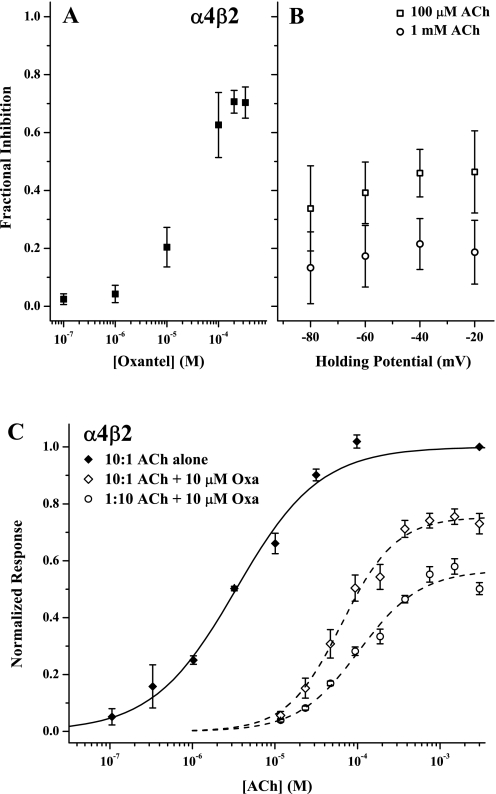Fig. 2.
Oxantel inhibition is noncompetitive and independent of subunit stoichiometry. A, fractional degree of inhibition by Oxa [(IACh − IACh+Oxa)/IACh] as a function of Oxa concentration. The control, uninhibited response was elicited with 100 μM ACh with the holding potential at −60 mV. B, data for a separate experiment to determine the voltage-dependence of Oxa inhibition. Currents were evoked with two ACh concentrations (100 μM and 1 mM) and inhibition by coapplication was measured. Symbols represent means ± S.E.M. for n = 4 oocytes for both experiments. C shows concentration-response data for ACh alone (♦) and in the presence of 10 μM Oxa (♢) for oocytes injected with RNA ratios of 10:1 α4:β2, and for ACh + 10 μM Oxa for oocytes injected with 1:10 α4:β2 (○). Symbols represent mean currents normalized to the response evoked by 3 mM ACh alone (± S.E.M.). Curves represent best fits of the Hill equation to the data. The parameters not reported elsewhere were EC50, 64 ± 7 μM; nH, 1.32 ± 0.17; Emax, 0.75 ± 0.02 (dashed curve, Oxa inhibition for 10:1 ratio) and EC50, 105 ± 12 μM; nH, 1.17 ± 0.13; Emax, 0.57 ± 0.02 (dashed curve, Oxa inhibition for 1:10 ratio); EC50, 9.2 ± 0.8 μM; nH, 0.75 ± 0.05 (ACh control for 10:1 ratio, omitted for clarity) and EC50, 3.4 ± 0.4 μM; nH, 0.86 ± 0.07 (solid curve, ACh control for 1:10 ratio). The replicates were n = 3 (ACh alone) and n = 4 and 5 (Oxa inhibition).

